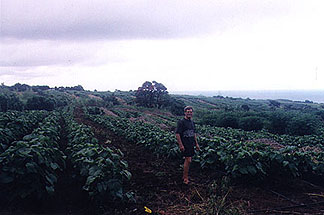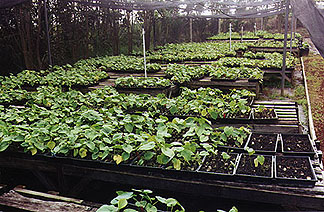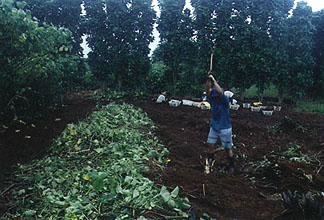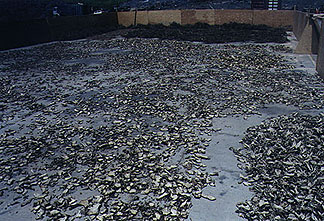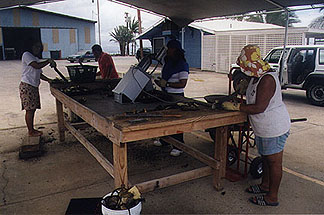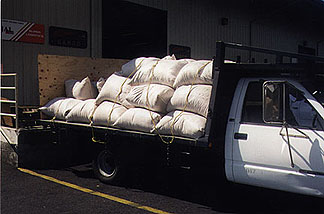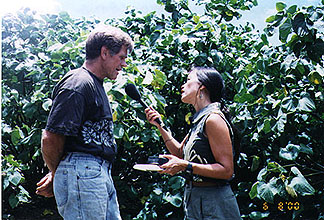Report on Kava (''awa) Plantation in Hawai'i, by John Bennett
I began with Wainani Farm as a Farm Manager back in June 1999, following completion of a contract to fabricate two Aloha Racing Cup boats for the Louis Vuitton Cup held in New Zealand. The farm was started by a German fellow who purchased the property in 1998 and grew papaya. One of his employees suggested they begin to diversify their crops by planting kava ('awa in Hawaiian). The stem material was gathered from several old Hawaiian plantations located in the gulches, where 'awa was customarily grown. Mahakea was the principle cultivar selected because it was popular among the ali'i and its chemotype is known to produce a eurphoric state. Five acres was prepared for planting 'awa and a nursery was established to begin propogating plants from stem material. Within a year 6000 plants (ie.-1200 plants/acre) were in the ground and an interest in 'awa as a psycho-active medicinal began to grow both locally, and worldwide.
I joined up with an Austrian in July, 1999 and we decided to expand the operation and seek an appropriate market. After lengthy negotiations we were able to secure a long-term contract with a nutricuetical company in Germany. Based on a guaranteed market and favourable results with the 'awa analysis, we decided to cultivate an additional 12 acres of 'awa. Over the past year we have developed the farm employing a range of both conventional and experimental planting techniques. The result is 30,000 plants in the ground which will be harvested over the next two years. By planting in open sunlight and augmenting plant growth with appropriate fertilisers and mulching, we are able to harvest most plants within two years at an average yield of more than 25 pounds per plant. This compares very favourably with plants traditionally harvested in 3-5 years with a yield of 9-30 pounds per plant. The KL (kavalactone) content is also optimised within 18 months resulting in a premium product for export.
We are presently the first operation in Hawai'i to establish a turnkey operation. Our plantation is located at Hakalau, on the Hamakua Coast. We have facilities for harvesting and washing nearby. The drying, along with value-added processing, is carried out in Kawaihae where the fresh 'awa is dried in the sun, shredded, and bagged for export. Our product has been so well received the nutricuetical company picks up the air-freight tab to get it sooner. We can now prepare an order for delivery from harvesting to shipping in less than a week.
The present dilemma is to provide enough 'awa to meet our contractual commitment. There is simply not enough 'awa grown in Hawai'i to meet the immediate or long-term demand. We now offer to buy as much 'awa as anyone has available at $1.00/lb.+ wet weight. I also offer bonuses for better quality 'awa. The advantage to the local farmer is that he/she can concentrate on growing and leave the drying, processing, and marketing to us. 'Awa is now considered a mainstream medicinal and can be taken in the form of a capsule, tea, tincture, paste, or powder. By growing one cultivar as a monoculture we offer continuity of quality and supply. This differs significantly from other suppliers in the South Pacific where consignments could include more than a dozen different chemotypes and as many different suppliers.
The greatest deterent to propogating 'awa in Hawai'i is the cost of labor. Overall improved quality and productivity along with mechanisation has enabled us to remain competitive with other suppliers and improve our market share, despite this problem. I would hope that in future, if the market continues to grow, farmers in Hawai'i will be prepared to work with our South Pacific neighbours to transfer appropriate technologies which will assist them to improve the quality of their products along with improving their market share. In turn we have much to benefit and learn from their understanding of traditional planting techniques and general use and administration. While western countries have carried out detailed research on 'awa's chemical characteristics, we have much to learn about the spiritual aspect of the 'awa plant and how to imbue it with a little mana and a lot of aloha. Only then will 'awa receive its due recognition as the peace plant of the new millenium.
|
